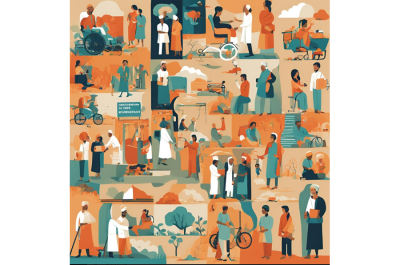Universal Health Coverage and India’s Diverse Landscape

Health is undoubtedly an overarching theme that influences a country’s socio-economic development. Access to good quality, affordable healthcare services for all plays a vital role in ensuring a nation’s health. This makes Sustainable Development Goal 3 (SDG 3) – Good Health and Well-Being, and specifically Target 3.8 – Universal Health Coverage (UHC), special for every country.
UHC should be visualized from three dimensions – the number of people/populations being covered, the types of services being covered, and the proportion of costs being covered. It is rightly said that the one-size-fits-all approach doesn’t suit policies, especially when it comes to the most populous country in the world – India. The challenges we face as a country regarding health are varied. Therefore, the approach should focus on equity rather than equality.
With 28 states, 8 union territories, and 766 districts, the country should adopt a more localized approach. Although the socio-economic performance of these states varies greatly, a comparison is essential to understand the growth and progress in terms of health and UHC.
To make the comparison more equitable, we can look at their performance in terms of the state’s size – large, small, and union territories. The large states in terms of population include Uttar Pradesh, Bihar, Maharashtra, West Bengal, Madhya Pradesh, Rajasthan, Tamil Nadu, Gujarat, Karnataka, Andhra Pradesh, Odisha, Jharkhand, Telangana, Assam, Kerala, Punjab, Haryana, Chhattisgarh, Jammu & Kashmir, Uttarakhand, and Himachal Pradesh. They can be compared based on the Health Index scores calculated using 24 indicators spanning three major domains – Health Outcomes, Governance and Information, and Key Inputs and Processes.
Among the large states, the southern states of Kerala, Tamil Nadu, and Andhra Pradesh have remained top performers. The health indicators show promising results for these states, with Kerala and Tamil Nadu having strong government healthcare systems with well-developed infrastructures. The states of Kerala, Odisha, and West Bengal have a higher prevalence of insurance coverage, with more than 30% of households covered. Karnataka, Punjab, Gujarat, and Himachal Pradesh can be classified as moderately covered states, with 20–30% of households being insured. The number stands at less than 15% for states like Maharashtra and Uttar Pradesh, making them low-coverage states, while the Hindi heartland – Madhya Pradesh – reflects very low coverage.
While state governments are trying their best to bring quality services to their states, Meghalaya sets an example that urges us to find localised approaches. This mountainous state, with its difficult geographical terrain, currently has the highest level of health coverage. With its own health policy focusing on UHC, they have given utmost importance to the power of local governance. The State Health Enhancement Program with envisioned a 3-D model focuses on both preventive and well-being system of healthcare. With three main components – Preventive, Curative, and Enabling – it takes into account the strengthening of Primary Health Centres (PHCs), insurance, and village-level interaction, which has proved beneficial, resulting in the improvement of several health indicators and setting an example for other states.
Leah Miriam George, the writer, is a Research Analyst at VeKommunicate.
